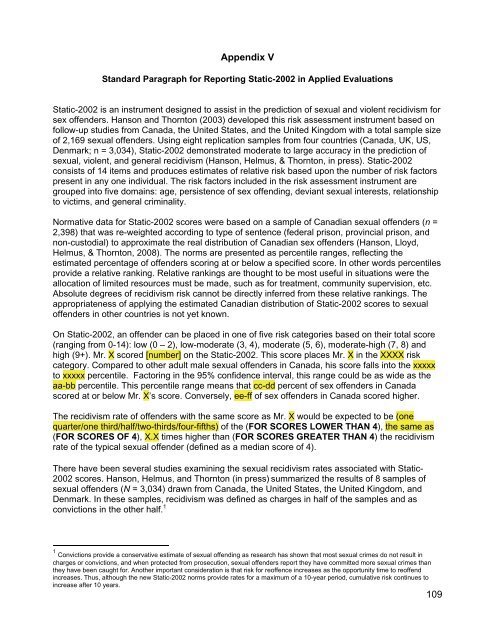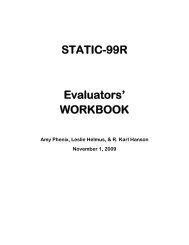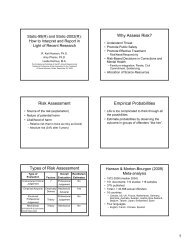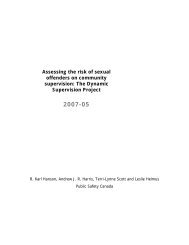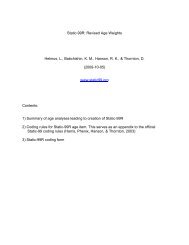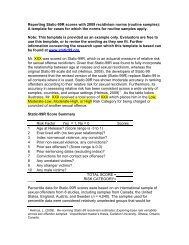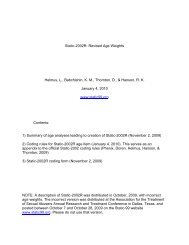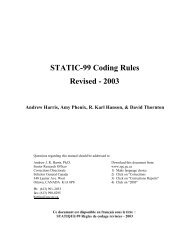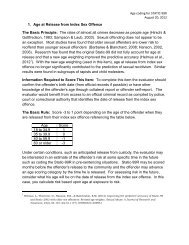Static-2002 coding rules (2009) - Static-99
Static-2002 coding rules (2009) - Static-99
Static-2002 coding rules (2009) - Static-99
Create successful ePaper yourself
Turn your PDF publications into a flip-book with our unique Google optimized e-Paper software.
Appendix V<br />
Standard Paragraph for Reporting <strong>Static</strong>-<strong>2002</strong> in Applied Evaluations<br />
<strong>Static</strong>-<strong>2002</strong> is an instrument designed to assist in the prediction of sexual and violent recidivism for<br />
sex offenders. Hanson and Thornton (2003) developed this risk assessment instrument based on<br />
follow-up studies from Canada, the United States, and the United Kingdom with a total sample size<br />
of 2,169 sexual offenders. Using eight replication samples from four countries (Canada, UK, US,<br />
Denmark; n = 3,034), <strong>Static</strong>-<strong>2002</strong> demonstrated moderate to large accuracy in the prediction of<br />
sexual, violent, and general recidivism (Hanson, Helmus, & Thornton, in press). <strong>Static</strong>-<strong>2002</strong><br />
consists of 14 items and produces estimates of relative risk based upon the number of risk factors<br />
present in any one individual. The risk factors included in the risk assessment instrument are<br />
grouped into five domains: age, persistence of sex offending, deviant sexual interests, relationship<br />
to victims, and general criminality.<br />
Normative data for <strong>Static</strong>-<strong>2002</strong> scores were based on a sample of Canadian sexual offenders (n =<br />
2,398) that was re-weighted according to type of sentence (federal prison, provincial prison, and<br />
non-custodial) to approximate the real distribution of Canadian sex offenders (Hanson, Lloyd,<br />
Helmus, & Thornton, 2008). The norms are presented as percentile ranges, reflecting the<br />
estimated percentage of offenders scoring at or below a specified score. In other words percentiles<br />
provide a relative ranking. Relative rankings are thought to be most useful in situations were the<br />
allocation of limited resources must be made, such as for treatment, community supervision, etc.<br />
Absolute degrees of recidivism risk cannot be directly inferred from these relative rankings. The<br />
appropriateness of applying the estimated Canadian distribution of <strong>Static</strong>-<strong>2002</strong> scores to sexual<br />
offenders in other countries is not yet known.<br />
On <strong>Static</strong>-<strong>2002</strong>, an offender can be placed in one of five risk categories based on their total score<br />
(ranging from 0-14): low (0 – 2), low-moderate (3, 4), moderate (5, 6), moderate-high (7, 8) and<br />
high (9+). Mr. X scored [number] on the <strong>Static</strong>-<strong>2002</strong>. This score places Mr. X in the XXXX risk<br />
category. Compared to other adult male sexual offenders in Canada, his score falls into the xxxxx<br />
to xxxxx percentile. Factoring in the 95% confidence interval, this range could be as wide as the<br />
aa-bb percentile. This percentile range means that cc-dd percent of sex offenders in Canada<br />
scored at or below Mr. X’s score. Conversely, ee-ff of sex offenders in Canada scored higher.<br />
The recidivism rate of offenders with the same score as Mr. X would be expected to be (one<br />
quarter/one third/half/two-thirds/four-fifths) of the (FOR SCORES LOWER THAN 4), the same as<br />
(FOR SCORES OF 4), X.X times higher than (FOR SCORES GREATER THAN 4) the recidivism<br />
rate of the typical sexual offender (defined as a median score of 4).<br />
There have been several studies examining the sexual recidivism rates associated with <strong>Static</strong>-<br />
<strong>2002</strong> scores. Hanson, Helmus, and Thornton (in press) summarized the results of 8 samples of<br />
sexual offenders (N = 3,034) drawn from Canada, the United States, the United Kingdom, and<br />
Denmark. In these samples, recidivism was defined as charges in half of the samples and as<br />
convictions in the other half. 1<br />
1 Convictions provide a conservative estimate of sexual offending as research has shown that most sexual crimes do not result in<br />
charges or convictions, and when protected from prosecution, sexual offenders report they have committed more sexual crimes than<br />
they have been caught for. Another important consideration is that risk for reoffence increases as the opportunity time to reoffend<br />
increases. Thus, although the new <strong>Static</strong>-<strong>2002</strong> norms provide rates for a maximum of a 10-year period, cumulative risk continues to<br />
increase after 10 years.<br />
109


